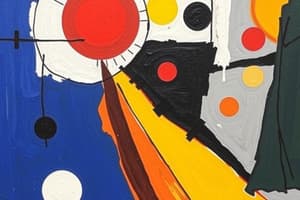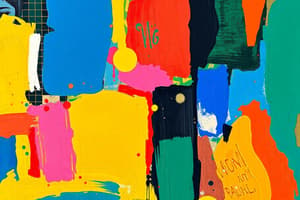Podcast
Questions and Answers
What is an Actual Line characterized by?
What is an Actual Line characterized by?
Which type of line is associated with calmness and stability?
Which type of line is associated with calmness and stability?
What does a Diagonal line primarily indicate in art?
What does a Diagonal line primarily indicate in art?
What is the term for the perceived farthest point from a viewer in an artwork?
What is the term for the perceived farthest point from a viewer in an artwork?
Signup and view all the answers
Which function of line is related to creating spatial relations?
Which function of line is related to creating spatial relations?
Signup and view all the answers
How can lines express emotions according to the content?
How can lines express emotions according to the content?
Signup and view all the answers
What characteristic of a line helps in depicting the shape and volume of objects?
What characteristic of a line helps in depicting the shape and volume of objects?
Signup and view all the answers
Which term refers to lines that suggest order when presented in parallel?
Which term refers to lines that suggest order when presented in parallel?
Signup and view all the answers
What does the subject of a work of art refer to?
What does the subject of a work of art refer to?
Signup and view all the answers
Which type of art is characterized by a complete departure from the real world?
Which type of art is characterized by a complete departure from the real world?
Signup and view all the answers
What is the primary difference between factual meaning and conventional meaning in art?
What is the primary difference between factual meaning and conventional meaning in art?
Signup and view all the answers
How is subjective meaning defined in the context of art?
How is subjective meaning defined in the context of art?
Signup and view all the answers
Which artist is associated with representational/figurative art?
Which artist is associated with representational/figurative art?
Signup and view all the answers
What are considered the building blocks of art?
What are considered the building blocks of art?
Signup and view all the answers
Which of the following statements about abstract art is true?
Which of the following statements about abstract art is true?
Signup and view all the answers
What does form in art refer to?
What does form in art refer to?
Signup and view all the answers
What characterizes geometric shapes?
What characterizes geometric shapes?
Signup and view all the answers
How do shapes differ from forms?
How do shapes differ from forms?
Signup and view all the answers
Which of the following best describes organic shapes?
Which of the following best describes organic shapes?
Signup and view all the answers
What is the main role of composition in art?
What is the main role of composition in art?
Signup and view all the answers
Which statement about forms is accurate?
Which statement about forms is accurate?
Signup and view all the answers
Which of the following is NOT a principle of design?
Which of the following is NOT a principle of design?
Signup and view all the answers
What is primarily influenced by the principles of design?
What is primarily influenced by the principles of design?
Signup and view all the answers
Which aspect of art creation is often overlooked yet crucial?
Which aspect of art creation is often overlooked yet crucial?
Signup and view all the answers
What does proportion in art primarily refer to?
What does proportion in art primarily refer to?
Signup and view all the answers
What effect can artists achieve by manipulating proportions?
What effect can artists achieve by manipulating proportions?
Signup and view all the answers
What is a motif in the context of creating rhythm in art?
What is a motif in the context of creating rhythm in art?
Signup and view all the answers
Which type of rhythm is characterized by identical parts separated by equal intervals?
Which type of rhythm is characterized by identical parts separated by equal intervals?
Signup and view all the answers
Which statement best describes irregular rhythm?
Which statement best describes irregular rhythm?
Signup and view all the answers
What role does visual movement play in art?
What role does visual movement play in art?
Signup and view all the answers
How can artists create movement in a composition?
How can artists create movement in a composition?
Signup and view all the answers
What visual effect does alternating rhythm create?
What visual effect does alternating rhythm create?
Signup and view all the answers
What is a significant theme in the kundiman during the latter half of the 19th century?
What is a significant theme in the kundiman during the latter half of the 19th century?
Signup and view all the answers
What does the zarzuela, or sarsuwela, primarily involve?
What does the zarzuela, or sarsuwela, primarily involve?
Signup and view all the answers
What is the primary narrative source of the senakulo?
What is the primary narrative source of the senakulo?
Signup and view all the answers
What does the komedya typically depict?
What does the komedya typically depict?
Signup and view all the answers
What event does the Basi Revolt chronicle?
What event does the Basi Revolt chronicle?
Signup and view all the answers
What is notable about the 'Doctrina Christiana' published in 1593?
What is notable about the 'Doctrina Christiana' published in 1593?
Signup and view all the answers
The 'Carta Hydrographica y Chorographica de las Yslas Filipinas' is significant because it is:
The 'Carta Hydrographica y Chorographica de las Yslas Filipinas' is significant because it is:
Signup and view all the answers
What is the primary focus of 'Flora de Filipinas' published in 1878?
What is the primary focus of 'Flora de Filipinas' published in 1878?
Signup and view all the answers
Study Notes
Artwork and Viewer Interaction
- Components of Art: SUBJECT (What - visual focus), CONTENT (Why - meaning), FORM (How - arrangement of elements).
-
Subjects:
- Representational Art: Depicts real-world objects/events (e.g., Da Vinci's "Mona Lisa").
- Non-representational Art: Lacks direct reference to the real world; focuses on visual elements (e.g., Pollock's "Convergence").
- Abstract Art: Departs from reality; extent of abstraction varies (e.g., Picasso's "Head of a Woman, Mougins").
Understanding Content in Art
- Factual Meaning: Basic meaning derived from identifiable forms and their relationships.
- Conventional Meaning: Interpretation based on established motifs, signs, and symbols recognized by audiences.
- Subjective Meaning: Viewer’s personal interpretation influenced by knowledge, experiences, and values.
Elements of Art
- Elements: Color, Line, Shape, Form, Texture, Space – fundamental components in art creation.
Line
- Characteristics: Basic element, continuous mark, varies in tone (thick, thin, light, dark).
-
Types of Line:
- Actual Line: Clearly visible.
- Implied Line: Created through positioning.
- Psychic Line: Viewer’s eye follows object placement.
-
Line Directions:
- Vertical: Strength, stability.
- Horizontal: Serenity, calmness.
- Diagonal: Movement, instability.
- Jagged: Conflict, chaos.
- Curved: Fluidity, gradual change.
-
Functions:
- Designate spatial relations and suggest order/disorder.
- Define shapes and volumes.
- Convey emotions through gesture lines.
Value
- Definition: Intensity of light and dark on surfaces.
- Application: Monochrome shading through pressure variations or layering to depict different shades.
Shape and Form
- Shape: Two-dimensional (height, width).
- Form: Three-dimensional (height, width, depth).
-
Types of Shape:
- Geometric Shape: Clear edges, structured forms (e.g., circles, rectangles).
- Organic Shape: Flowing, natural, asymmetrical.
Principles of Design
- Composition: Critical arrangement of elements in a work, affecting viewer experience.
- Proportion: Relationship of sizes among elements; crucial for realism and can emphasize certain aspects artistically.
- Movement: Creates impression of action; reliant on rhythm, line, and balance.
-
Rhythm: Repetition of elements, influencing visual tempo and interaction.
- Types of Rhythm: Regular (identical intervals), alternating (different components), irregular (natural variations).
Philippine Artistic Context
- Kundiman: A song genre reflecting revolutionary sentiments and love for the Philippines.
- Zarzuela/Sarsuwela: A musical theater form blending singing and prose.
- Senakulo: Narrative art based on biblical passion stories, adapted into local language.
- Komedya: Depicts historical conflicts within Christian and Islamic narratives; often ends with reconciliation.
- Heaven, Earth, and Hell (1850): A depiction warning against sinful living, showcasing the consequences in hell.
- Basi Revolt (1821): Historical account of rebellion against the Spanish monopoly.
- Doctrina Christiana (1593): The first printed book in the Philippines, a catechetical resource.
- First Scientific Map of the Philippines (1734): Created by Fr. Pedro Murillo Velarde and associates.
- Flora de Filipinas (1878): Comprehensive guide to Philippine plant species.
Studying That Suits You
Use AI to generate personalized quizzes and flashcards to suit your learning preferences.
Description
This quiz explores the fundamental components of art, focusing on the subject, form, and content. Participants will gain insights into how these elements interact to create meaning and enhance viewer comprehension. Ideal for art students or enthusiasts seeking to deepen their understanding.




